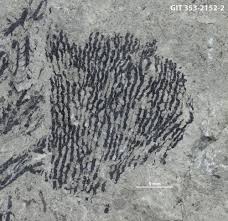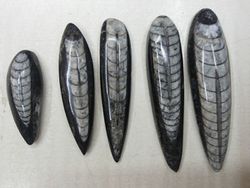Fossils/Invertebrates
- Main article: Fossils
This page is incomplete. |
Kingdom Animalia
Sponges (Phylum Porifera)
| Picture(s) | 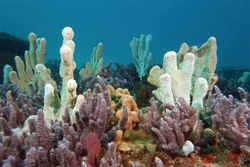
|
|---|---|
| Common Names | Sponges |
| Physical Description | Their bodies do not contain tissue, muscles, nerves, or organs. Some are composed of silica spicules, and others of calcium carbonate. They generally do not have body symmetry, but some sponges have radial symmetry. Their bodies are hollow and held together by jelly-like substances which have many cells. Cells on the outside can move inwards and change function. Their pores are called ostia. |
| Fossil Range | Precambrian to Recent. Sponges reached their greatest diversity during the Cretaceous period. |
| Taxonomy | Kingdom: Animalia. |
| Mode of Life or Habitat | They are benthic and sessile, and live in marine and freshwater environments. Sponges are free-swimming in their larval stages. Sponges can have a symbiotic relationship with blue-green algae (shallow sponges are more likely to do this). Sponges can be reef builders, being able to house organisms such as nematodes, crustaceans and mollusks in the osculum (center chamber). |
| Adaptations Over Time | They were the first to branch off from the common ancestor of all animals, so they're the sister group of all other animals. The shapes of their bodies are adapted for maximal efficiency of water flow through the central cavity. Some specimens can move at around 1-4 mm a day. |
| Distribution | Sponges are worldwide in their distribution, living in a wide range of ocean habitats. |
| Etymology | Porifera means "pore bearer." |
| Additional Information | They pump water through the body to feed, and have one body orifice to serve for ingestion as well as excretion. |
| External Links | https://en.wikipedia.org/wiki/Sponge. http://personal.kent.edu/~alisonjs/paleo/paleolab2porifera.htm. |
Genus Astraeospongia (calcareous sponge)
| Picture(s) | 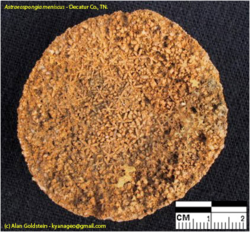
|
|---|---|
| Fossil Range | Silurian to Devonian |
| Mode of Life or Habitat | It lived in marine environments. |
| Additional Information | The spicules were the only part of the sponge that got fossilized, and there are star-shapes spicules all over the body (though they can be faint). |
| External Links | https://www.academia.edu/12178341/Species_Name_Astraeospongia_meniscus_MORPHOLOGICAL_ASPECTS_AND_ITS_LIFE.
https://scholarworks.uni.edu/cgi/viewcontent.cgi?article=6146&context=pias. https://www.jstor.org/stable/1300159?seq=2#metadata_info_tab_contents. http://personal.kent.edu/~alisonjs/paleo/paleolab2porifera.htm. |
Genus Hydnoceras (glass sponge)
This fossil will only be tested at the State and National levels.
| Picture(s) | 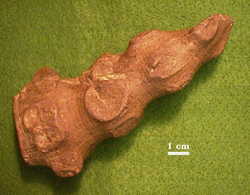
|
|---|---|
| Common Names | Glass sponge (this name refers to all of class Hexactinellida). |
| Physical Description | It is composed of silica spicules, which provided structural support and deterred enemies. |
| Fossil Range | Devonian to Pennsylvanian |
| Taxonomy | Class: Hexactinellida |
| Mode of Life or Habitat | Reef builder. |
| Distribution | Eastern United States and Europe |
| Additional Information | Class Hexactinellida is still extant but is now found only in the deep ocean. In the past, they could be found at almost all depths. Hydnoceras is a good index fossil and is usually preserved as internal molds. |
| External Links | http://personal.kent.edu/~alisonjs/paleo/paleolab2porifera.htm. |
Bryozoans (Phylum Bryozoa)
| Picture(s) | 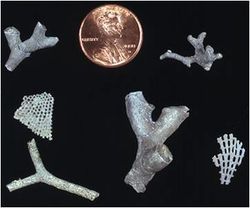
|
|---|---|
| Common Names | Moss animals |
| Physical Description | The structure seen when looking at a Bryozoan is actually a support structure composed of calcium carbonate. The animal itself lives in tiny holes in that structure, and is rarely larger than a millimeter. They appear very similar to corals, but are very, very different in biology. Bryozoans come in three growth forms: massive (a mound with no planned shape), branching (where the structure forms intricate branches), and fenestrate (where in life the bryozoan would have large, soft appendages coming out from the skeleton). |
| Fossil Range | They evolved in the Ordovician, and are still found today. Are most commonly found in Paleozoic rocks |
| Taxonomy | Kingdom: Animalia Clade: Lophophorata |
| Mode of Life or Habitat | They attached to the bottom of the ocean, and were filter feeders. |
| Distribution | Bryozoans are found on every continent except Antarctica. Most lived in a shallow marine environment, but nowadays can also be found in fresh water. |
| Additional Information | They produce a compound known as bryostatin 1, which is currently being tested as an anti-cancer drug. Bryozoans can reproduce both sexually and asexually. |
| External Links | https://en.wikipedia.org/wiki/Bryozoa. |
Genus Archimedes
| Picture(s) | 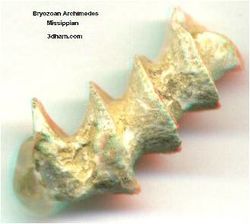
|
|---|---|
| Physical Description | It was a fenestrate bryozoan that was much wider in life than it seems from the fossil. Individual animals are called zooids. Fossils are ~2 cm long. In life, it had calcified tissue that held the edge of the lacy colony with the axis usually preserved alone. |
| Fossil Range | Carboniferous to Permian, ~345-268 mya. |
| Taxonomy | Class: Stenolaemata Order: Fenestrata Family: Fenestellidae |
| Mode of Life or Habitat | Benthic and sessile filter feeders. Lived in clear, shallow marine waters. They preferred clear water because murky water clogs the zooecia in which they live. |
| Distribution | Are mainly found throughout Europe and North America, but they have also been found in sediments of Afghanistan, Canada, Russia, and Australia. They lived in shallow marine waters. |
| Etymology | It was named for the Greek thinker Archimedes, who invented the water screw - Archimedes fossils look very much like screws. |
| External Links | https://en.wikipedia.org/wiki/Archimedes_(bryozoan). |
Genus Rhombopora
| Picture(s) | 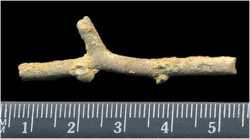
|
|---|---|
| Physical Description | A branching bryozoan. Has a calcified skeleton made of tubes. Individual zooids form zooeciums, sacs that they secrete and live in. They attach to the substrate via a holdfast structure. |
| Fossil Range | Carboniferous to Permian. |
| Taxonomy | Class: Stenolaemata Order: Rhabdomesida Family: Rhomboporidae |
| Mode of Life or Habitat | Benthic and sessile filter feeders. Lived in clear, shallow marine waters. |
| Distribution | Widespread across North America and Asia. |
| Etymology | The genus name comes from its rhombus-shaped holes. |
| External Links | https://en.wikipedia.org/wiki/Rhombopora. |
Graptolites (Phylum Hemichordata)
This fossil will only be tested at the State and National levels.
| Picture(s) | 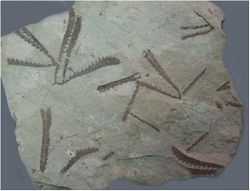
|
|---|---|
| Common Names | Graptolites |
| Physical Description | Fossils look like pencil marks on a rock. They consisted of colonies of microscopic organisms with a threefold body division. The three body parts are the proboscis/protostome, the collar, and the trunk. Each colony comes from an initial zooid (the sicular zooid). Every other zooid then develops from that initial zooid. The colony is connected via tubes called stolons. The entire colony is housed in a theca, also called a rhabsodome, coenocium, or tubarium, likely made of either collagen or chitin, which the graptolites secrete through the cephalic shield. |
| Fossil Range | Cambrian to end of Carboniferous. |
| Taxonomy | Kingdom: Animalia Clade: Ambulacraria |
| Mode of Life or Habitat | Usually deposit feeders, though some species are filter feeders. |
| Adaptations Over Time | They are thought to be on the path that led to the vertebrates. |
| Distribution | Worldwide - excellent index fossils for the Paleozoic. |
| Additional Information | Geologists can divide the rocks of the Ordovician and Silurian periods into graptolite (class Graptolithina) biozones; these are generally less than one million years in duration. A worldwide ice age at the end of the Ordovician eliminated most graptolites except the neograptines. Diversification from the neograptines that survived the Ordovician glaciation began around 2 million years later. Some of the greatest extinctions that affected the group were the Hirnantian in the Ordovician and the Lundgreni in the Silurian, where the graptolites populations were dramatically reduced. They are usually fossilized by means of carbonization in shale. |
| External Links | https://en.wikipedia.org/wiki/Hemichordate. https://en.wikipedia.org/wiki/Graptolithina. |
Order Dendroidea (benthic graptolites)
This fossil will only be tested at the State and National levels.
Order Graptoloidea (planktic graptolites)
This fossil will only be tested at the State and National levels.
Corals (Phylum Cnidaria)
| Picture(s) | 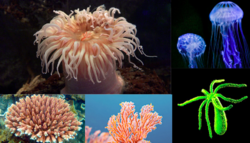 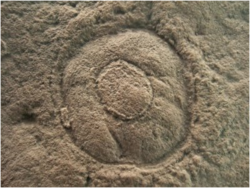
|
|---|---|
| Common Names | Includes jellyfish, corals, and hydras. |
| Physical Description | Cnidarians use nematocysts to catch prey and have tissue “organs.” They are radially symmetric with a sac-like body. Coral has skeletal cups known as corallites. The inside of the corallite is called the calyx. The vertical blades in the calyx are known as septa which may continue outside the corallite wall as costae. |
| Fossil Range | Ediacaran (Precambrian, ~580 mya) to modern-day. |
| Taxonomy | Kingdom: Animalia |
| Mode of Life or Habitat | Usually marine. Polyps (e.g. corals) are benthic and sessile. Jellyfish are motile and planktonic. |
| Additional Information | The cnidarian group contains jellyfish, sea anemones, and corals. They all use stinging cells known as nematocysts to capture prey, which is usually plankton. Modern corals have a symbiotic relationship with algae. |
| External Links | https://en.wikipedia.org/wiki/Cnidaria. https://en.wikipedia.org/wiki/Corallite. |
Order Tabulata (tabulate corals)
| Picture(s) | 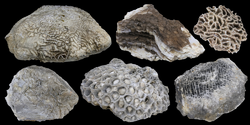
|
|---|---|
| Common Names | Tabulate Corals |
| Physical Description | They form colonies of hexagonal cells (corallites), with a calcite skeleton. They have well-developed horizontal internal partitions (tabulae) within each cell, but reduced or absent vertical internal partitions (septa). They vary in shape with their platforms usually straight and complete. Tabulate corals also display radial symmetry, and the septa, if present, are always very short and prickly. |
| Fossil Range | Ordovician to Permian. They became extinct in the Permian–Triassic extinction event. |
| Taxonomy | Class: Anthozoa |
| Mode of Life or Habitat | They were almost always colonial. Shallow waters. |
| Additional Information | Preserved by limestone and calcareous shale. |
| External Links | https://en.wikipedia.org/wiki/Tabulata. https://palaeopost.blogspot.com/2016/08/the-difference-betweenrugose-tabulate.html. |
Genus Favosites
| Picture(s) | 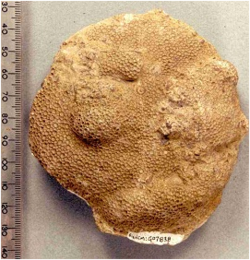
|
|---|---|
| Common Names | Honeycomb coral. |
| Physical Description | A specimen can be anywhere from a few centimeters to tens of centimeters in all dimensions. Is easily recognizable by the honeycomb-like appearance when viewed from above. Corallites (individual structure that houses each coral animal/polyp) were about 1/16 in (2mm) wide and in length they were long, narrow, closely packed tubes. They were colonial. Septa are not present or are short irregular spines. Mural pores in the walls of the corallites allow transfer of nutrients from polyp to polyp. Filter-fed on plankton using stinging tentacles. Calcium carbonate substrate. |
| Fossil Range | Late Ordovician to Late Permian, 488-251 mya. It is commonly found in Silurian limestone. |
| Taxonomy | Family: Favositidae |
| Mode of Life or Habitat | Benthic and sessile. Lived in warm, shallow, and sunlit seas. |
| Adaptations Over Time | They had a symbiotic relationship with photosynthetic algae. |
| Distribution | Every continent except Antarctica. |
| Etymology | The name comes from favus, Latin for "honeycomb." |
| Additional Information | Rising sea levels during the Devonian caused them to become less common. |
| External Links | https://en.wikipedia.org/wiki/Favosites. https://fossillady.wordpress.com/2010/09/05/what-is-a-favosite/. |
Genus Halysites
This fossil will only be tested at the State and National levels.
| Picture(s) | 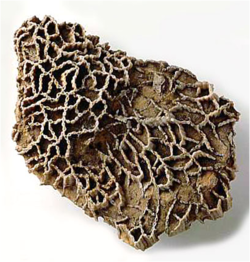
|
|---|---|
| Common Names | Chain coral, due to its growth pattern. |
| Physical Description | Made of calcite. Individual corallites were cylindrical and 2 mm long and wide. Each corallite held a single polyp. Corallites are more widely spaced in Halysites than in many other tabulate corals. Distinctive chain shape. Colonies range in diameter from <1 to 10s of centimeters. |
| Fossil Range | Late Ordovician to Early Devonian, 450-412 mya. They thrived in the Silurian. |
| Taxonomy | Family: Halysitidae |
| Mode of Life or Habitat | Benthic and sessile. Lived in warm, shallow waters. Suspension feeder. |
| Adaptations Over Time | They had a symbiotic relationship with hermit crabs and algae. |
| Distribution | Widespread over North America. They have been found in sediments of Canada, the US, Europe, Asia, and Australia. |
| Etymology | The name comes from halysis, Greek for "chain." |
| Additional Information | It is an index fossil for the Silurian. |
| External Links | https://en.wikipedia.org/wiki/Halysites. |
Order Rugosa (rugose corals)
| Picture(s) | 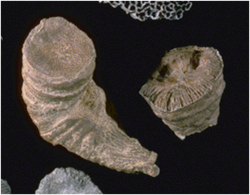
|
|---|---|
| Common Names | Tetracorals, horn corals, and cup corals. |
| Physical Description | Shape of a wrinkled horn. May be solitary or colonial. Could grow up to 1 meter long. Large corallites. They have well-developed septa in groups of four (modern corals have groups of six, subclass Hexacorallia). They have a skeleton made of calcite. They have bilateral symmetry. Probably had stinging tentacles to capture prey. Have well-developed tabulae. They sometimes possess dissepiments, curved plates that connect the septa and tabulae. They start with four major septa and then grow minor septa. The central line is called the columella, which gives support for solitary corals. |
| Fossil Range | Middle Ordovician to Late Permian. |
| Taxonomy | Class: Anthozoa |
| Mode of Life or Habitat | Shallow water. Benthic, sessile micro-carnivores. |
| Adaptations Over Time | Some lived inside Stromatoporoidea sponges (endosymbiosis), especially in the Silurian. |
| Etymology | Name comes from rūgōsus, Latin for "wrinkled." |
| External Links | https://en.wikipedia.org/wiki/Rugosa. https://palaeopost.blogspot.com/2016/08/the-difference-betweenrugose-tabulate.html. |
Genus Heliophyllum (horn coral)
| Picture(s) | 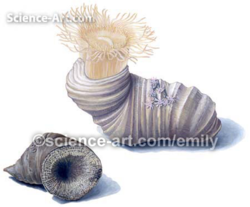
|
|---|---|
| Common Names | Horn coral. |
| Physical Description | ~3 cm long horns. May be solitary or colonial. It fed using its nematocysts to stun prey. |
| Fossil Range | Devonian. |
| Taxonomy | Family: Zaphrentidae |
| Mode of Life or Habitat | Shallow waters. Benthic and sessile. |
| Distribution | They had a wide distribution, including both Americas, Asia, and Europe. |
| Etymology | Horn corals get their name from their body shape, which is horn-like. |
| Additional Information | Heliophyllum growth patterns are used to calculate the length of the Devonian day and year. |
| External Links | https://en.wikipedia.org/wiki/Heliophyllum. |
Genus Hexagonaria
| Picture(s) | 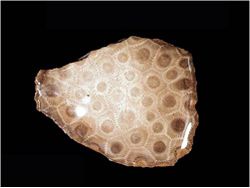
|
|---|---|
| Physical Description | Bilateral symmetry. Thick walls and septa with hexagonal corallites. Colonial. Each corallite of the Hexagonaria is made up of a usually six-sided compartment that adjoins the others in the colony and creates an elaborate hexagon. The backbones of the coral are made of calcite in both life and fossilization. |
| Fossil Range | Devonian, 416-359 mya |
| Taxonomy | Family: Disphyllidae |
| Mode of Life or Habitat | Warm, shallow waters. Benthic and sessile. |
| Distribution | It was very widely distributed around the world. |
| Etymology | Comes from the hexagonal corallites. |
| Additional Information | Petoskey stones (H. percarinata fossils) are the state stone of Michigan. Formed through glaciation, where stones were plucked from the bedrock and grinded into smooth rocks, eventually deposited into the northwestern portion of Michigan’s lower peninsula. |
| External Links | https://en.wikipedia.org/wiki/Hexagonaria. |
Order Scleractinia (stony corals)
| Picture(s) | 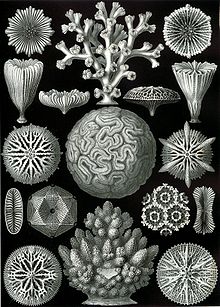
|
|---|---|
| Common Names | Stony corals, hard corals. A type of hexacoral. |
| Physical Description | Radial symmetry. The skeleton of an individual scleractinian polyp is known as a corallite. All modern scleractinian skeletons are composed of calcium carbonate in the form of crystals of aragonite. Well-developed septa. Absent tabulae. |
| Fossil Range | Middle Triassic - Recent. Scleractinian corals are the only corals that are alive today. |
| Taxonomy | Class: Anthozoa Subclass: Hexacorallia |
| Mode of Life or Habitat | Although some species are solitary, most are colonial. Hermatypic corals (the world’s primary reef builders) live in shallow tropical waters and are mostly colonial while ahermatypic corals live in all regions of the ocean, are either colonial or solitary, and do not build reefs. |
| Distribution | Occur in all oceans. |
| Etymology | The name Scleractinia is New Latin, based on Ancient Greek σκληρός (sklērós, "hard") + ἀκτίς (aktís, "ray"). |
| Additional Information | Polyps reproduce asexually by budding. |
| External Links | https://en.wikipedia.org/wiki/Scleractinia. https://palaeopost.blogspot.com/2016/08/the-difference-betweenrugose-tabulate.html. https://ucmp.berkeley.edu/cnidaria/scleractinia.html. |
Genus Septastrea
| Picture(s) | 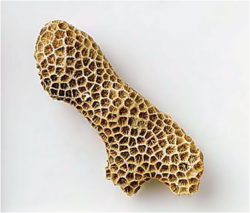
|
|---|---|
| Physical Description | The corallites are around 6 mm long. The polyps have horn shapes and 6 long and 6 short septa. Septastrea did not form reefs. Their morphology is variable, being able to grow into just about any shape. |
| Fossil Range | Paleogene to Pleistocene. |
| Taxonomy | Family: Rhizangiidae |
| Mode of Life or Habitat | Benthic and sessile. Usually lived in shallow, warm water, but were able to survive in deeper, colder water. Azooxanthellae (they do not live in symbiosis with photosynthetic algae). Suspension feeder. |
| Distribution | Every continent except Antarctica. Very prevalent along the Atlantic Coastal Plain. |
| Additional Information | http://fossilworks.org/?a=taxonInfo&taxon_no=96564. |
Arthropods (Phylum Arthropoda)
| Picture(s) | 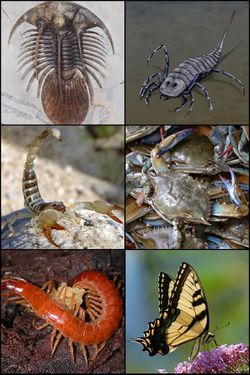
|
|---|---|
| Common Names | Arthropods |
| Physical Description | They are invertebrates and have segmented bodies, an exoskeleton, and many limbs. The exoskeleton is made of chitin and sometimes calcium carbonate. |
| Fossil Range | Cambrian - Recent. |
| Taxonomy | Kingdom: Animalia |
| Distribution | Almost anywhere |
| Etymology | From Greek ἄρθρον arthron, "joint" and πούς pous, "foot." |
| Additional Information | This is the phylum that contains the "creepy-crawlies" of today. Arachnids, insects, and the like are all arthropods. |
| External Links | https://en.wikipedia.org/wiki/Arthropod. |
Subphylum Crustacea (shrimp, lobster, crabs, barnacles, ostracods)
This fossil will only be tested at the State and National levels.
| Picture(s) | 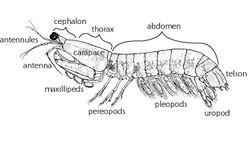
|
|---|---|
| Common Names | Crustaceans. |
| Physical Description | Crustaceans use antennae for swimming. They have 2-parted limbs and a chitin shell. Their bodies are divided into the head, thorax, and abdomen (sometimes referred to as the cephalothorax and abdomen). They have gills to obtain oxygen. They have 2 pairs of sensory antennae and 3 pairs of limbs used to push food into the mouth. They moult their exoskeleton in order to grow. They have an open circulatory system. |
| Fossil Range | Cambrian - Recent. They became abundant during the Carboniferous. |
| Mode of Life or Habitat | They are mostly marine animals, though some are common in freshwater and some are partially terrestrial. They can be benthic, planktonic, nektonic, or pseudo-planktonic. |
| External Links | https://en.wikipedia.org/wiki/Crustacean. |
Subphylum Chelicerata
| Picture(s) | No pictures have been added as of yet. |
|---|---|
| Common Names | Sea spiders, arachnids, and eurypterids. |
| Fossil Range | Middle Cambrian to today |
| Etymology | New Latin, from French chélicère, from Greek χηλή, khēlē "claw, chela" and κέρας, kéras "horn" |
| External Links | https://en.wikipedia.org/wiki/Chelicerata. |
Order Eurypterida (eurypterids)
| Picture(s) | 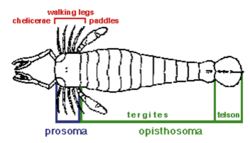
|
|---|---|
| Common Names | Sea scorpions |
| Physical Description | Eurypterids have abdomens with 7 segments, 8 legs with the last pair being paddle-like, and tails. They are the largest-known arthropods ever to exist, the largest measuring in at 2.5 meters long or possibly more (although most were under 8 inches long). |
| Fossil Range | Middle Ordovician - Late Permian (Although the earliest fossils of eurypterids date back to the Ordovician, the level of complexity already exhibited by the group indicates that they evolved in the Cambrian). They suffered greatly during the Late Devonian extinction and became extinct during the Permian-Triassic extinction. Eurypterids were most diverse during the Devonian and Silurian periods. |
| Taxonomy | Class: Merostomata The eurypterids belonged to the same group that modern-day horseshoe crabs are classified in. As arachnids, they are related to modern day spiders and scorpions. |
| Additional Information | When they were first discovered, paleontologists thought that they were ancient catfish- it was seven years later that they became identified as arthropods. More detail is known about the external anatomy of eurypterids than any other group of fossils, and they are almost as well known as modern animals. |
| External Links | https://en.wikipedia.org/wiki/Eurypterid. |
Class Insecta (Insects)
| Picture(s) | 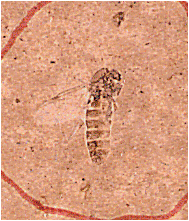
|
|---|---|
| Common Names | Insects |
| Physical Description | Insects have antennae, heads, 3-part thoraxes which have 3 pairs of legs, and abdomens. They have chitin exoskeletons which must be shed periodically and are not mineralized unlike other arthropods. Most undergo metamorphosis with pupae as resting stages. Over time, they grew wings (in the Carboniferous) and modified mouthparts. |
| Fossil Range | Early Devonian to recent. By the Cretaceous, all modern forms of insects had appeared. |
| Taxonomy | Subphylum: Hexapoda |
| Mode of Life or Habitat | Terrestrial and freshwater. One of the first animals to adapt to land. |
| Distribution | Worldwide |
| Etymology | Insecta is Greek for "cut into pieces." |
| Additional Information | Insects were not visibly affected by the extinction of the dinosaurs at the end of the Cretaceous. Terrestrial insects are usually not fossilized because their exoskeletons are not mineralized. |
| External Links | https://en.wikipedia.org/wiki/Insect. |
Class Trilobita (Trilobites)
| Picture(s) | 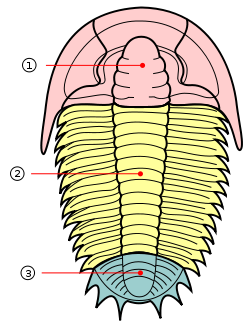 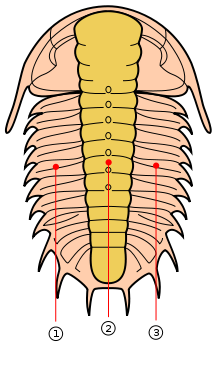
|
|---|---|
| Common Names | Trilobites |
| Physical Description | The first image identifies the sections of a trilobite's body: 1- cephalon, 2-Throax, 3-pygidium. The second image identifies the lobes that gives trilobites their name: 1- Left pleural, 2-Axial, 3-Right pleural. Trilobites are named for their bodies, which are divided into three lobes, which run longitudinally along the body. The trilobite's body is also divided into three sections. They had legs, which were probably made of chitin, and antennae. Trilobites had spikelike structures on each side of the cephalon known as "free cheeks", which fell off during molting. |
| Fossil Range | Cambrian to Devonian except the genus Proetida which lived until the Permian Mass Extinction. They were the most diverse at the end of the Cambrian. |
| Taxonomy | Subphylum: Trilobitomorpha |
| Mode of Life or Habitat | Most of them lived benthically, but some may have been pelagic or planktonic. Most of them were detritus feeders, but some may have been active predators and scavengers. They lived in shallow seas. After the Ordovician, they moved from shallow water to deep water. |
| Distribution | Worldwide. |
| Etymology | Trilobite comes from tri + lobe + ite, meaning "three lobes." |
| Additional Information | They are good index fossils. Most fossils are shed skeletons filled with sediment (internal molds). This is the major class of arthropods competitors will be asked about. |
| External Links | https://en.wikipedia.org/wiki/Trilobite. |
Genus Cryptolithus
| Picture(s) | 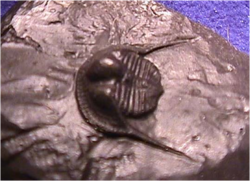
|
|---|---|
| Common Names | It is also known as the "lace collar trilobite", because the front edge of its cephalon looks somewhat like lace. |
| Physical Description | Cryptolithus is 1.3 cm long and wide. Its head shield is crescent shaped, its glabella is large (either smooth or with indistinct furrows), its genal spine is twice the length of its skeleton, its thorax has 6 segments with the middle lobe straight, and its tail shield (pygidium) is short, wide, and rounded sub-triangular. It has a short and wide cephalon with small holes. The laces were used to filter out food particles. It is easily identifiable by its long free cheeks, and its unbelievably squashed appearance. Cryptolithus was a small trilobite. |
| Fossil Range | Ordovician |
| Taxonomy | Order: Asaphida Family: Trinucleidae |
| Mode of Life or Habitat | Probably just ate detritus on the bottom of the ocean. Benthic deposit feeders. |
| Distribution | The US (Oklahoma, Kentucky, New Jersey, Pennsylvania, Virginia, and New York), Canada, Venezuela, the UK, France, the Czech Republic, Morocco, and Turkey. |
| Etymology | Cryptolithus means "hidden stone" in Ancient Greek. |
| Additional Information | It was almost completely blind. |
| External Links | https://en.wikipedia.org/wiki/Cryptolithus. |
Genus Calymene
| Picture(s) | 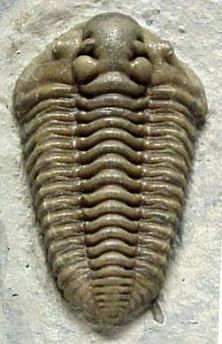
|
|---|---|
| Physical Description | It is typically 2 cm in length. They have a Holochroal eye. Most have 13 segments in the thorax, but some have 19 segments. The cephalon is the widest part of the organism. They are frequently preserved as tightly rolled fossils. |
| Fossil Range | Early Ordovician to Early Devonian, ~483-409 mya. They were the most abundant in the Silurian. |
| Taxonomy | Order: Phacopida Family: Calymenidae. |
| Mode of Life or Habitat | They lived in a marine environment, both shallow and deep. |
| Distribution | They are found throughout North America, North Africa, and Europe. |
| Etymology | Its name means "beautiful crescent." |
| Additional Information | It is the state fossil of Wisconsin. |
| External Links | https://en.wikipedia.org/wiki/Calymene. |
Genus Elrathia
| Picture(s) | 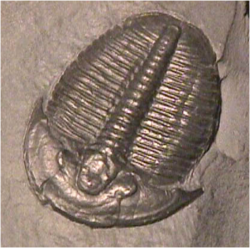
|
|---|---|
| Physical Description | They were 2.5 cm long, 1.6 cm wide with the head shield much bigger than the tail shield. They had wide thoraxes with 12-17 segments, short spines, and a narrow and well-defined middle lobe. |
| Fossil Range | Middle Cambrian. Oldest trilobite on the list. |
| Taxonomy | Order: Ptychopariida Family: Alokistocaridae |
| Mode of Life or Habitat | Benthic particle feeders. Lived in the exaerobic zone of the ocean, characterized by low oxygen levels. |
| Distribution | It is widespread in North America. It is commonly found in the Wheeler Formation in Utah. |
| Etymology | Its name is based off the town Elrath, Cherokee County, Alabama, where Elrathia was discovered. |
| External Links | https://en.wikipedia.org/wiki/Elrathia. |
Genus Isotelus
This fossil will only be tested at the State and National levels.
| Picture(s) | 
|
|---|---|
| Physical Description | It was the largest trilobite. Three species of Isotelus grew to almost a meter long, and Isotelus rex is world’s largest trilobite ever found as a complete fossil. It also possessed pits around the body that some think housed sensory hairs. The thorax had 8 segments. It had large, crescentic, and holochroal eyes, large heads, and large tails. Some reached a length of more than 80 cm. They are flat. They had few thoracic segments (only eight). Isotelus is isopygous, meaning the cephalon (head) and pygidium (tail) are roughly the same size. |
| Fossil Range | Middle-Upper Ordovician, ~500-480 mya |
| Taxonomy | Order: Asaphida Family: Asaphidae |
| Mode of Life or Habitat | Shallow and deep marine. May have been benthic/infaunal, probing shallowly for prey/carcasses. |
| Distribution | Restricted to Europe and North America. Common in Eastern US-Canada area and northwestern Manitoba. |
| Additional Information | Ohio adopted Isotelus as the state fossil in 1985. |
| External Links | https://www.britannica.com/animal/Isotelus. https://en.wikipedia.org/wiki/Isotelus. https://www.cambridge.org/core/journals/journal-of-paleontology/article/worlds-biggest-trilobiteisotelus-rex-new-species-from-the-upper-ordovician-of-northern-manitoba-canada/055501529DC4DFBB308024AD413A3B4E. |
Genus Eldredgeops (formerly Phacops)
| Picture(s) | 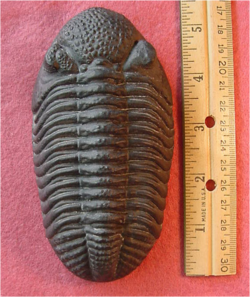
|
|---|---|
| Physical Description | They were 4 cm long and 2 cm wide. The head and tail shields are bluntly rounded, the glabella was large, and the thorax had 11 segments. They had parallel sides and had differently placed eyes, so they could see in almost all lateral directions. Their eyes were schizochroal (with compound lenses, each with separate corneas) and had fewer lenses than those of other trilobites. |
| Fossil Range | Middle Devonian, ~444-359 mya. Died out in the Kačák Event, involving high insolation levels, high temperatures, and a rising sea level. |
| Taxonomy | Order: Phacopida Family: Phacopidae |
| Mode of Life or Habitat | Warm, shallow seas. |
| Adaptations Over Time | They would ball up in response to predators. Unlike many trilobites, they could fully roll up, the cephalon making a tight seal with the pygidium. |
| Distribution | Eldredgeops and Phacops are two similar genera which were separated by the Rheic Ocean, a narrow sea. North Africa, the Middle East, and South Europe specimens are Phacops while North America and Northern European specimens are Eldredgeops. |
| Additional Information | The Pennsylvania General Assembly designated E. rana as the state fossil on December 5, 1988. The specific name rana is a reference to the trilobite’s frog-like eyes and is Latin for frog. See https://en.wikipedia.org/wiki/Eldredgeops for a summary of the differences between Eldredgeops and Phacops. Eldredgeops is readily used as an index fossil for the Devonian period. |
| External Links | https://statesymbolsusa.org/symbol-official-item/pennsylvania/state-dinosaur-fossil/trilobite. https://www.fossilguy.com/gallery/invert/arthropod/trilobite/phacops/index.htm. https://en.wikipedia.org/wiki/Paleontology_in_Pennsylvania. https://en.wikipedia.org/wiki/Phacopidae. |
Brachiopods (Phylum Brachiopoda)
| Picture(s) | 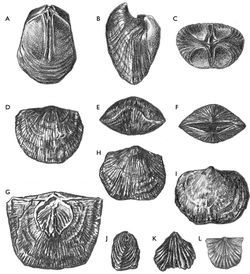
|
|---|---|
| Common Names | Lamp shells. |
| Physical Description | Brachiopods are a diverse group of lophophorates that are externally very similar to clams and other bivalves. They are divided into two groups, inarticulate and articulate. They have 2 valves, and the ventral valve is bigger than the dorsal one. The symmetry and arrangement of soft parts are different from those of Phylum Bivalvia. The individual valves are bilaterally symmetrical. The lophophore is located in the dorsal valve and the posterior near the hinge line and has a pair of arms known as brachia. They have growth lines on their shells. |
| Fossil Range | Were diverse in the Paleozoic. |
| Taxonomy | As lophophorates, their closest relatives are bryozoans. |
| Mode of Life or Habitat | Cold, deep marine environments. Solitary and exhibit very little movement. Most extinct brachiopods were benthic, and most today attach themselves to a firm substrate using their fleshy stalks. |
| Etymology | Name comes from brachio (Latin) + pod (Greek), "arm-foot." |
| External Links | https://en.wikipedia.org/wiki/Brachiopod. |
Class Inarticulata
| Picture(s) | No pictures have been added as of yet. |
|---|---|
| Physical Description | No teeth or sockets (they lack any tooth-and-groove features of the valve-hinge). They hold their shells together using muscles. Most inarticulate brachiopods are less than 1 cm in size, smaller than articulate brachiopods. Their shells were composed of calcium phosphate. |
| Fossil Range | Cambrian - recent. |
| Taxonomy | Can be separated into groups of Linguliformea and Craniformea. |
| Mode of Life or Habitat | Although they were originally shallow marine organisms, today's brachiopods are only found in the deep ocean. They could be either epifaunal or infaunal in nature, depending on the species. They were filter feeders. |
| Distribution | Worldwide |
| External Links | https://en.wikipedia.org/wiki/Brachiopod. |
Genus Lingula
| Picture(s) | 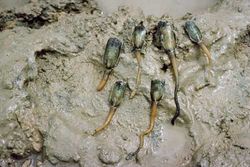
|
|---|---|
| Physical Description | It is known for having a very long pedicle, which anchored it to the sea floor. It can be detected by a short row of three openings through which it takes in water (sides) and expels it again (middle). They are around 1.6 cm long and 1.0 cm wide. |
| Fossil Range | Silurian (questionable) to recent. Lingula could have existed in the Cambrian. |
| Taxonomy | Class: Lingulata Order: Lingulida Family: Lingulidae |
| Mode of Life or Habitat | It lived in vertical burrows in intertidal areas and fed on detritus. Infaunal. |
| Distribution | Worldwide. |
| Etymology | Name means "little tongue" in Latin because of its thin, tongue-shaped shell. |
| Additional Information | It is the oldest known animal genus. Darwin classified it as a living fossil. However, this status is questionable, as the shape of Lingula corresponds to a burrowing lifestyle which could have evolved in numerous ways in unrelated brachiopod lineages. |
| External Links | https://en.wikipedia.org/wiki/Lingula_(brachiopod). |
Class Articulata
| Picture(s) | 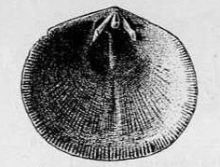 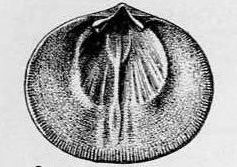
|
|---|---|
| Physical Description | Articulate brachiopods have two valves that are different size. The larger shell is called the pedicle valve - contains a hole through which a fleshy stalk called a pedicle attaches to a substrate (rocks or sediment on the sea floor). The pedicle acts as an anchor that firmly holds the brachiopod in place. Brachiopods are immobile throughout adult life. The pedicle valve contains projections called teeth, which fit into sockets on the opposite brachial valve. |
| Fossil Range | Cambrian to recent. They flourished during Paleozoic (570-240 mya) and Mesozoic (240-65 mya) eras. |
| Mode of Life or Habitat | Most live in moderately deep water. They are sessile benthic suspension feeders. |
| Additional Information | They make up 95% of known brachiopod genera. |
| External Links | https://en.wikipedia.org/wiki/Brachiopod. |
Genus Atrypa
| Picture(s) | 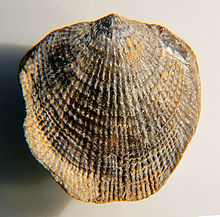
|
|---|---|
| Physical Description | Atrypa has shells round to short egg-shaped, covered with many fine radial ridges, that split further out. The brachial valve is very convex and was 1.2 cm long. The brachiopods have distinctive concentric growth lines. In Devonian beds, the brachial valve is often missing, most likely because of tidal action. |
| Fossil Range | Late Ordovician to Early Carboniferous, ~444-318 mya. |
| Taxonomy | Class: Rhynchonellata Order: Atrypida Family: Atrypidae |
| Mode of Life or Habitat | Filter-feeders. Attached themselves to soft substrates of shallow marine environments worldwide. |
| Distribution | Atrypa can be found on every continent except Antarctica. |
| Additional Information | Since Atrypa was assigned early-on, species from it have been split into around 20 genera such as Desquamatia and Spinatrypa. Atrypa is one of the most common Paleozoic brachiopods. |
| External Links | https://en.wikipedia.org/wiki/Atrypa. |
Genus Composita
| Picture(s) | 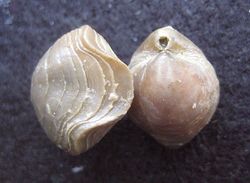
|
|---|---|
| Physical Description | 1 in (25 mm) long and wide. Composita had a small and smooth shell with a more or less distinct fold and sulcus and a round and very obvious opening for the pedicle on the pedicle valve. Given the smooth shell, it was perfectly suited to survive in turbulent environments. Its shell is made of calcite. |
| Fossil Range | Found from the Upper Devonian to the Permian. Especially abundant in Permian deposits. |
| Taxonomy | A related genus is Athyris. Class: Rhynchonellata Order: Athyridada Family: Thyrididae |
| Mode of Life or Habitat | Filter-feeders that attached themselves to the seafloor of shallow and warm marine environments. |
| Distribution | Worldwide. Abundant and widespread. It is widespread in North America. |
| Additional Information | They are often present in rock with much shell debris. |
| External Links | https://en.wikipedia.org/wiki/Composita. |
Genus Juresania
This fossil will only be tested at the State and National levels.
| Picture(s) | 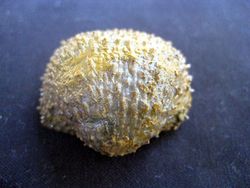
|
|---|---|
| Physical Description | It was about 16 mm long and 22 mm wide. It had a round outline, a convex ventral, and was covered with numerous small spines. These small spines were found on both halves of the shell, and are the easiest way to identify Juresania. It had very fine costae. 1.6 cm long and 2.2 cm wide. There are concentric ridges in the posterior area. The brachial valve is convex, but the dorsal valve is concave. |
| Fossil Range | Late Devonian to Late Permian |
| Taxonomy | Class: Strophomenata Order: Productida Family: Echinococcus |
| Mode of Life or Habitat | Filter-feeders that attached themselves to the seafloor of shallow marine environments. |
| Distribution | Nebraska, Kansas, Oklahoma, Texas, Nevada. In North America and across Asia. |
| Additional Information | Juresania is common in Beattie limestone and mostly in limestone or shale. |
| External Links | https://en.wikipedia.org/wiki/Juresania. |
Genus Leptaena
| Picture(s) | 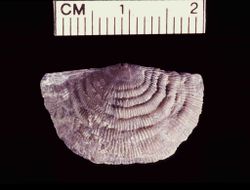
|
|---|---|
| Physical Description | Distinctive thick growth lines. 4 cm long. Semicircular (fan-shaped). It is best identified by concentric wrinkling in the shell, which is finely striated. The ridges are used to stabilize it in soft substrates. The dorsal valve is convex, and the brachial valve is flat. |
| Fossil Range | Ordovician to Early Devonian (possibly to Early Carboniferous or even Permian). |
| Taxonomy | Class: Strophomenata Order: Strophomenida Family: Rafinesquinidae |
| Mode of Life or Habitat | Filter feeders that attached themselves to the seafloor of marine environments. |
| Adaptations Over Time | The flat shape allowed sediment to gather on top of it. |
| Distribution | Worldwide. Widespread in North America, China, Norway, and the UK. |
| Additional Information | Commonly found in Wenlock limestone. |
| External Links | https://en.wikipedia.org/wiki/Leptaena. |
Genus Mucrospirifer
| Picture(s) | 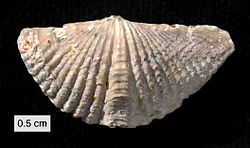
|
|---|---|
| Common Names | Butterfly shells. |
| Physical Description | They were typically 2.5 cm long but sometimes grew to 4. The hinge line extends outwards, making sharp points. The brachiopods' big surface area would help it float on top of the mud while the "wings" would sort in-going and outgoing water currents. Mucrospirifer was strophic, meaning it had a well-defined hinge. |
| Fossil Range | Middle Devonian to Early Carboniferous, mainly Middle Devonian. |
| Taxonomy | Class: Rhynchonellata Order: Spiriferida Family: Mucrospiriferidae |
| Mode of Life or Habitat | Filter feeders that attached themselves to soft and muddy substrates of shallow marine environments. |
| Distribution | Worldwide, except Australia and Antarctica. |
| Etymology | "Mucrospirifer" means "sharply pointed spire-bearer." |
| External Links | https://en.wikipedia.org/wiki/Mucrospirifer. |
Genus Platystrophia
| Picture(s) | 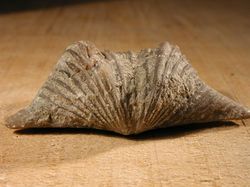
|
|---|---|
| Physical Description | 3/4 in (19 mm) long, 1¼ in (32 mm) wide. Their shells were made out of calcite, and they lost their pedicles as they aged. Each valve of the shell is convex in profile, and the hinge line between the valves is wide. Surface markings on the shell include prominent angular ridges and intervening linear depressions. |
| Fossil Range | Middle Ordovician through Upper Silurian. |
| Taxonomy | A related genus is Vinlandostrophia. Class: Rhynchonellata Order: Orthida Family: Plectorthidae |
| Mode of Life or Habitat | They lived in quiet intertidal zones, shallow and deep marine. They were filter feeders that attached themselves to a substrate. |
| Distribution | Worldwide. |
| External Links | https://en.wikipedia.org/wiki/Platystrophia. |
Genus Rafinesquina
| Picture(s) | 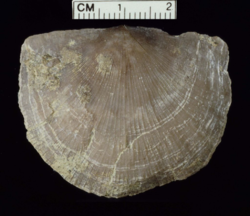
|
|---|---|
| Common Names | Nicknamed the "cursed brachiopod" because lingulids (since they are infaunal) could get buried in sediment and then trapped under the large shell of a Rafinesquina brachiopod, unable to bury their way up, resulting in group deaths (one Rafinesquina fossil has 28 lingulids underneath it). |
| Physical Description | Their valves are semi-circular (D-shaped), flat and thin; the brachial valve is convex while the dorsal valve is flat to concave. Have both radiating and concentric striae. The costae (the parts in between the radiating striae) are fine. Width is usually greater than length (around 2.8 cm and 2.2 cm, respectively). |
| Fossil Range | Middle Ordovician to Late Silurian. |
| Taxonomy | Class: Strophomenata Order Strophomenida, Family Rafinesquinidae. |
| Mode of Life or Habitat | Filter feeders that attached themselves to the seafloor of shallow marine environments. |
| Distribution | Widespread in North America |
| Etymology | Named to honor Professor Constantine Rafinesque, who argued that organisms could evolve long before Darwin. When he was fired from his job as a professor at Transylvania University, Lexington, Kentucky, he cursed the institution, after which there was a string of fires and deaths. |
| Additional Information | Good index fossil for the Ordovician. In 1982, Gary D. Rosenberg proposed that the number of days in a Late Ordovician lunar month could be estimated by counting the growth lines of Rafinesquina. |
| External Links | https://en.wikipedia.org/wiki/Rafinesquina. https://www.dispatch.com/article/20131004/NEWS/310049695. |
Order Rhynchonellida
| Picture(s) | 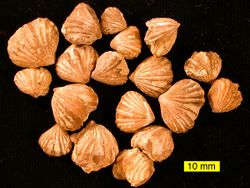
|
|---|---|
| Physical Description | They have small and highly inflated biconvex shells with coarse, large ribs. Their shells are made of calcium phosphate, Ca3(PO4)2. Shaped like a wedge. They have folds on the brachial valve and grooves on the ventral valve. Their shells come to a point (non-strophic). They did not have brachiums which meant there was nothing supporting the lophophore, meaning the order could survive many extinctions. It has an unusual zigzag commissure line. |
| Fossil Range | Late Ordovician to present-day. In the Mesozoic, they were the most abundant brachiopod. A few species still exist today. |
| Taxonomy | Class: Rhynchonellata |
| Mode of Life or Habitat | They are sessile, epifaunal suspension feeders. |
| Adaptations Over Time | They have changed little since their appearance in the Ordovician. |
| Additional Information | They were the first articulate brachiopods. |
| External Links | https://en.wikipedia.org/wiki/Rhynchonellida. https://ucmp.berkeley.edu/brachiopoda/rhynchonellida.html. |
Mollusks (Phylum Mollusca)
| Picture(s) | No pictures have been added as of yet. |
|---|---|
| Physical Description | Bilaterally symmetrical. Relatively big (>2 cell layers with organs and tissues) with no cavities. All molluscs have a mouth, gut, and anus, along with an open circulatory system, a pair of kidneys, and a nervous system. Many molluscs have a ctenidium, or feathery gill organ. Molluscs display annual growth lines. |
| Fossil Range | Evolved during the Cambrian. |
| Taxonomy | Molluscs evolved from Phylum Platyhelminthes, or flatworms, as they slowly became bigger and more complex. Kingdom: Animalia |
| Mode of Life or Habitat | Some herbivorous molluscs use their radula as a rake to comb up algae filaments from the seafloor. |
| Distribution | Worldwide. |
| Etymology | Mollusc comes from the Latin for "soft body." |
| External Links | https://en.wikipedia.org/wiki/Mollusca. |
Class Bivalvia (clams, oysters, mussels)
| Picture(s) | No pictures have been added as of yet. |
|---|---|
| Common Names | Bivalve/pelecypods. Includes oysters, clams, mussels, and scallops. |
| Physical Description | They may look superficially like brachiopods. Bivalves have two calcareous valves (either aragonite or calcite) that are secreted by the mantle (outer layer of tissue) and an umbo, a large hump representing the oldest part of the bivalve with the middle being the beak, at the dorsal side of each valve. The two shells are joined at the dorsal end by the ligament. Bivalves usually have two adductor muscles for closing the shell, but some mollusks, such as scallops, have one, central adductor muscle. The plane of commissure is the vertical orientation that a bivalve can most efficiently burrow. |
| Fossil Range | Early Cambrian - Recent. The first freshwater bivalves appeared in the Devonian. |
| Mode of Life or Habitat | Mostly marine, but some live in lakes and streams. Many bivalves burrow into the sediment. Bivalves can be shallow infaunal, deep infaunal, or epifaunal. They are found in almost all aquatic habitats. Most are filter feeders, but some are scavengers or active predators. |
| Distribution | Worldwide. |
| Etymology | "Bivalvia" means "two valves." |
| External Links | https://en.wikipedia.org/wiki/Bivalvia. |
Genus Exogyra
| Picture(s) | 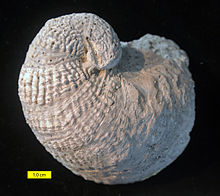
|
|---|---|
| Common Names | Devil’s toenails, foam oysters, honeycomb oysters. |
| Physical Description | The left valve is deep and twisted into a spiral while the right valve is much smaller and flat. There is a large flat to concave part on the umbo of the left valve where the shell was cemented. Were 9 cm long and 10 cm high. Their shells are very durable and made of aragonite. |
| Fossil Range | Late Jurassic to Late Cretaceous. |
| Taxonomy | Subclass: Pteriomorphia Order: Ostreoida Family Gryphaeidae |
| Mode of Life or Habitat | Epifaunal. Saltwater oysters that cemented on solid substrates in warm seas. Filter feeders. |
| Distribution | Worldwide. |
| Additional Information | Some of the most distinctive and common bivalves from the Cretaceous Period. Many of them survived as fossils due to the thick shells which were not easily destroyed. |
| External Links | https://en.wikipedia.org/wiki/Exogyra. |
Genus Gryphaea
| Picture(s) | 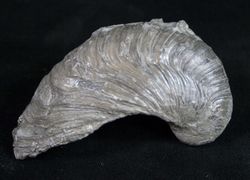
|
|---|---|
| Common Names | They are also known as the "Devil's toenails" because of their shape (the larger valve is called "the toenail"). |
| Physical Description | They are oysters. They have a cupped left valve and a flatter right valve. The shell was so convoluted that in some mature specimens, the shell would not be able to open, and the adult died. The shell was made of calcite and was very thick and heavy. |
| Fossil Range | Late Triassic/Early Jurassic to Eocene. |
| Taxonomy | Subclass: Pteriomorphia Order: Ostreoida Family Gryphaeidae |
| Mode of Life or Habitat | They lived on muddy sea beds, cemented to a small particle of rock. They were infaunal suspension feeders. |
| Distribution | Worldwide (rare in North America but abundant in Europe). Common in Eastern England. |
| Etymology | "Gryphaea" means "gryphon." |
| External Links | https://en.wikipedia.org/wiki/Gryphaea. |
Genus Pecten
| Picture(s) | 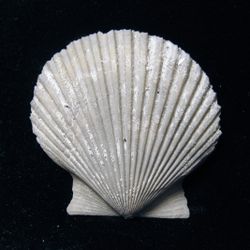
|
|---|---|
| Physical Description | Scallops that were up to 20 cm long and more than 8.5 cm wide. They have flat shells and distinct flat extensions to the hinge line called "wings." |
| Fossil Range | Cretaceous to present-day. |
| Taxonomy | Subclass: Pteriomorphia Order: Ostreoida Family: Pectinidae |
| Mode of Life or Habitat | Filter feeders (planktonic diet) that lived on sand and gravel. They are fixed to the substratum when young but become motile when mature. They are able to swim by clamping together their two lightweight valves and forcing water out of the hinge. They live in clean sand in moderately shallow waters where they rest on the bed in self-made depressions. |
| Distribution | Worldwide. |
| Etymology | Pecten is the Latin word for comb, rake, or scallop. |
| Additional Information | Pecten was used for the basis of the Shell Oil Company's logo. |
| External Links | https://en.wikipedia.org/wiki/Pecten_(bivalve). |
Genus Glycymeris
| Picture(s) | 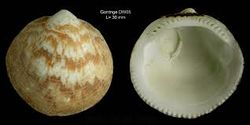
|
|---|---|
| Common Names | Bittersweet clam |
| Physical Description | They have medium-sized thick aragonite shells which are almost circular. The surface is either smooth or radially ribbed. The hinge is heavy, with a row of 6-12 teeth. The outside of the hinge ligament has no transverse striations. |
| Fossil Range | Early Cretaceous (Valanginian age, ~140-136 mya) to present-day. They reached maximum diversity in the Cretaceous. |
| Taxonomy | Inclues about 100 extinct species. Subclass: Pteriomorphia Order: Arcoida Family: Glycymerididae |
| Mode of Life or Habitat | They burrow into the sand and mud in shallow saltwater beds. Facultatively mobile. Infaunal suspension feeders. They prefer beds with heterogeneous-grained sediments. |
| Adaptations Over Time | They evolved convergently with genus Composita. |
| Distribution | Worldwide. Today, they are common in North Carolina. |
| Etymology | Ancient Greek word glykymaris, perhaps from glykys (sweet) + meris (part). The word glykymaris is recorded only once in Greek literature. This genus was named by Carl Linnaeus in 1758. |
| External Links | https://en.wikipedia.org/wiki/Glycymeris. |
Genus Astarte
| Picture(s) | 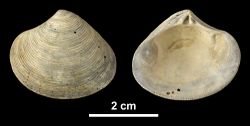
|
|---|---|
| Physical Description | Characterized by a pointed umbo. An Astarte bivalve has two well-defined adductor scars and a clear pallial line that connects them. ~5 cm wide. The shells lack ribbing and are always longer than they are high. |
| Fossil Range | Ordovician to present-day. |
| Taxonomy | The taxon was defined by James Sowerby in 1816. Subclass: Heterodonta Order: Carditida Family: Astartidae |
| Mode of Life or Habitat | Marine: mainly temperate, shallow water. They were benthic suspension feeders. |
| Distribution | Worldwide (including Antarctica). Proliferated during the Jurassic. Mainly Northern Hemisphere in the present-day. At least five species are currently found in the North Atlantic American coast. Around nine of its species can be found in European waters. |
| Etymology | Named after the goddess Astarte, a goddess of war and sexual love in the modern Middle East. |
| Additional Information | Signaled that the Bering Strait had opened by the Late Miocene or Early Pliocene (somewhere between 4.8 and 7.4 mya), much earlier than previous estimates of 3.1-4.1 mya. This was because A. borealis and A. hopkinsi dwelled only in the Arctic Ocean and therefore the findings of them in the Milky River Formation in southwestern Alaska indicate that they had migrated into the North Pacific through the Bering Strait. |
| External Links | https://paleobiodb.org/classic/basicTaxonInfo?taxon_no=17370. https://www.researchgate.net/publication/305883454_The_Astarte_Bivalvia_Astartidae_that_document_the_earliest_opening_of_Bering_Strait. https://www.researchgate.net/figure/Left-valve-of-Astarte-donax-illustrating-the-primary-morphological-features-of-the_fig5_266162180. |
Genus Nucula
| Picture(s) | 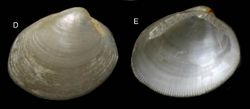
|
|---|---|
| Common Names | Nut clams. |
| Physical Description | Can reach a size of around 3.0 cm. Equivalve, symmetrical, approximately triangular. Fine growth lines. They have a layer of nacre (mother of pearl) that coats their inner shell. They have interlocking shell hinge teeth. |
| Fossil Range | Early Ordovician (Arenig age) to present-day. |
| Taxonomy | Taxonomy of Nuculidae is based mainly on their feces. Subclass: Protobranchia Order: Nuculida Family: Nuculidae |
| Mode of Life or Habitat | Marine. Infaunal, live just under the surface of muddy sand at a depth of 20-200 m. Filter-feeders. They are benthic selective deposit feeders, feeding on a variety of microzooplankton, organic matter, and microbes. |
| Distribution | Worldwide. |
| Etymology | Nucula comes from Latin for "little nut." |
| Additional Information | Many species have barely changed, surviving relatively unmodified to the present-day. |
| External Links | https://en.wikipedia.org/wiki/Nucula. https://www.shellmuseum.org/post/2015/09/11/the-atlantic-nut-clam. |
Class Cephalopoda
| Picture(s) | No pictures have been added as of yet. |
|---|---|
| Common Names | Fishermen sometimes call them inkfish. The cephalopod group includes squids, octopuses, cuttlefish, and nautiluses. |
| Physical Description | Bilateral symmetry, a prominent head, and tentacles. They also have appendages coming from the mouth used for feeding, mobility, and reproduction. |
| Fossil Range | Late Cambrian to present-day. |
| Mode of Life or Habitat | Oceans. Primarily predatory. |
| Distribution | Worldwide. |
| Etymology | The name cephalopod comes from cephalo ("head") + pod ("foot"). |
| External Links | https://en.wikipedia.org/wiki/Cephalopod. |
Subclass Ammonoidea
| Picture(s) | No pictures have been added as of yet. |
|---|---|
| Physical Description | Ammonoids have chambered shells called phragmocones. It is divided by thin walls called septa, and the chambers are called camerae and get progressively larger. As the ammonoid grows, new and bigger changers are added. The animal occupied the last and biggest chamber, known as the body chamber. In involute ammonoids, the outer whorl largely covers the smaller whorls, but in evolute ammonoids (such as Dactylioceras), it does not. A thin siphuncle extends from the body into the empty camerae, emptying water out of them, allowing the ammonoid to change its buoyancy and rise and descend. The mechanism used to transport water through the siphuncle is a hyperosmotic active transport process. While in nautiloids, the siphuncle runs through the center of the septa, in ammonoids, it runs on the inside surface of the shell close to the outer rim. Ammonoids are thought to have displayed sexual dimorphism, the shell of the female (macroconch) being slightly bigger and thinner than that of the male (microconch) to accommodate egg production. This is because similar trends have been observed in modern Nautilus. While earlier paleontologists thought that the two shells were different species, it is more likely that they are two different sexes of the same species since they are consistently found together. Ammonoid shells are usually flat spirals but can come in many different shapes such as straight or curious ox-bow patterns. Ammonoids can even be spiraled as a juvenile and straight as an adult. Ammonoids have distinctive suture patterns. The three orders of ammonoid on the list all have examples of each suture pattern. The three major categories are:
|
| Fossil Range | Devonian to Cretaceous. |
| Mode of Life or Habitat | Probably lived in open water. Marine. |
| Etymology | Comes from Latin ammonis cornua ("horns of Ammon"), coined by Pliny the Elder (died 79 CE). Ammon is an Egyptian god, typically depicted as having ram horns, which the coiled shell of an ammonoid resembles. |
| Additional Information | Excellent index fossils. |
| External Links | https://en.wikipedia.org/wiki/Ammonoidea. |
Order Goniatitida (goniatites)
This fossil will only be tested at the State and National levels.
| Picture(s) | 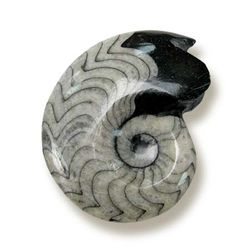
|
|---|
Order Ceratitida (ceratites)
This fossil will only be tested at the State and National levels.
| Picture(s) | 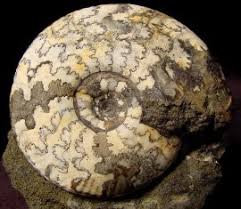
|
|---|
Order Ammonitida (ammonites)
| Picture(s) | 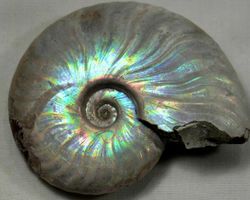 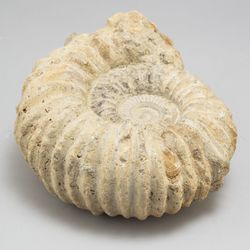
|
|---|
Genus Baculites
| Picture(s) | 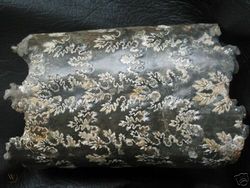
|
|---|---|
| Physical Description | It was anywhere from 7 cm from 2 meters in length. Males were smaller than females and had lighter ribbing. The shell had a few tight whorls and many chambers which would fill with air to increase buoyancy. The shells are straight with blunt apexes. The suture line is extremely foliated. |
| Fossil Range | Upper Cretceous |
| Taxonomy | Order: Ammonitida Family: Baculitidae |
| Mode of Life or Habitat | Marine. It was carnivorous and lived in the middle of the water column. There is much debate over whether they lived upright with tentacles on the sea bed for foraging for food, or if they lived horizontally and near the surface of the water. |
| Distribution | Worldwide. Widespread in North America. |
| Etymology | "Baculum" means walking stick in Latin. |
| Additional Information | It is used as an index fossil. |
| External Links | https://en.wikipedia.org/wiki/Baculites. http://fossilworks.org/bridge.pl?a=taxonInfo&taxon_no=14603. |
Genus Dactylioceras
| Picture(s) | 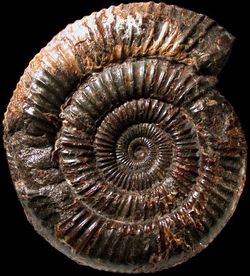
|
|---|---|
| Physical Description | They have ribbed shells which are around 6.5 cm long. They have a strong shell with ribs that are slightly inclined forward and closely spaced. |
| Fossil Range | Early Jurassic, ~180 mya. |
| Taxonomy | Order: Ammonitida Family: Dactylioceratidae |
| Mode of Life or Habitat | They were slow swimmers, and probably scavenged on the seafloor. They spawned in clusters, and may have often died shortly after spawning. |
| Distribution | Worldwide. The best specimens are found in England and Germany. Many specimens are found in the Mazon Creek lagerstatten. |
| Etymology | Their name (dactyl) means "finger" in Greek, referring to the ribs on the shell. |
| Additional Information | Excellent index fossils. The Whitby Town Football Club coat of arms has three Dactylioceras specimens. Often found as wave-rolled cliff debris on the beach. |
| External Links | https://en.wikipedia.org/wiki/Dactylioceras. https://andysfossils.com/2013/12/01/the-whitby-ammonite-or-a-whole-lot-of-variation/. |
Order Belemnitida (Belemnites)
| Picture(s) | No pictures have been added as of yet. |
|---|---|
| Common Names | Fossil bullets. Devil’s fingers. St. Peter’s fingers. |
| Physical Description | Ranges from a few centimeters to around 4 meters (with a 46 cm rostrum). |
| Fossil Range | Middle Triassic to Late Cretaceous. |
| Taxonomy | Subclass: Coleoidea Superorder: Belemnoidea. |
| Mode of Life or Habitat | Marine. Found in littoral and near-shelf zones. Predatory. Preyed on by crocodilians, ichthyosaurs, and plesiosaurs. |
| Adaptations Over Time | Guards became more spearheaded, a more hydrodynamic shape. |
| Distribution | Originally only in Europe (the eastern coast of what was then Lauraisa) but moved worldwide. |
| Etymology | From Ancient Greek βέλεμνον (bélemnon, "dart, arrow"). |
| Additional Information | In 2009, a solidified black ink sac was found in the UK. Can be used to determine paleocurrent, as fossils will be aligned with the direction of the current at the point of their deposition. The oxygen isotope ratios (O-18 to O-16) in the rostrum calcite can be used to determine the paleotemperature (sea water temperature). Some folk traditions hold that they are flung down from heaven during thunderstorms. Some traditions believe them to have medicinal powers, e.g. for sore eyes or rheumatism. "Belemnite battlefields" are mass accumulations of belemnite rostra, thought to have been caused by mass death after mating. |
| External Links | https://en.wikipedia.org/wiki/Belemnitida. https://en.wiktionary.org/wiki/belemnite. https://www.bgs.ac.uk/discovering-geology/fossils-and-geological-time/belemnites/. |
Genus Belemnitella
| Picture(s) | 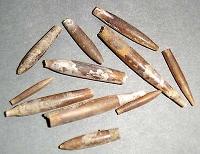
|
|---|---|
| Physical Description | Squid-like, as can be seen in one specimen in Germany that preserved 10 tentacles as carbon films. Closely related to squids and cuttlefish. They are about 17 cm long and 2 cm wide. They had 10 arms which had inward-curving hooks used for grasping prey. They had a hard internal skeleton (the rostrom or guard), unlike modern squids. The rostrom is long and narrow with a blunt apex, made of fibrous calcite crystals. The rostrum may have acted as a counterbalance to the head and tentacles. The apex of the rostrum is the back of the squid. Cross-sections of the rostrum show growth layers, with the pale layers made of calcite and the dark layers colored by organic matter. The phragmocone is the chambered inner shell made of aragonite. They had 10 tentacles/arms, with 30-50 pairs of chitinous hooks each. |
| Fossil Range | Upper Cretaceous, 85-66 mya. |
| Taxonomy | Family: Belemnitellidae |
| Mode of Life or Habitat | They swam in shallow waters. They used their hooked tentacles to catch small prey. Larger hooks could have been used for mating. Their main predator was ichthyosaurs. |
| Distribution | Northern Hemisphere, in Europe, North America, and the North Pacific. |
| Etymology | From Ancient Greek βέλεμνον (bélemnon, "dart, arrow"). |
| Additional Information | Usually, only the rostrum, or guard, is fossilized. The tentacle hook is also sometimes preserved. It is the state fossil of Delaware. Can be found in massive concentration in "belemnite graveyards." Good index fossils. |
| External Links | https://en.wikipedia.org/wiki/Belemnitella. http://www.fossilsofnj.com/invertebrates/belemnitella.htm. https://en.wiktionary.org/wiki/belemnite. https://www.bgs.ac.uk/discovering-geology/fossils-and-geological-time/belemnites/. |
Order Nautilida (Chambered Nautilus)
| Picture(s) | 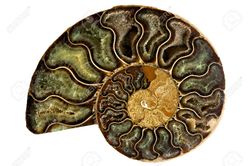
|
|---|
Order Orthocerida ("Orthoceras")
Class Gastropoda (Snails)
| Picture(s) | No pictures have been added as of yet. |
|---|---|
| Common Names | Snails, slugs, limpets, and sea hares. Univalves. |
| Physical Description | Well-defined head with 2 or 4 sensory tentacles with eyes and a foot. The shell is in one piece and is usually coiled. These shells may be either coiled left-handed (sinistral, spiraled counter-clockwise) or right-handed (dextral, spiraled clockwise). Adults are asymmetrical: during larval development, their shell rotates 180° relative to their head in a phenomenon known as torsion. Evolutionarily, the advantages for this could include better defense from predators (as the head can be retracted into the shell), the prevention of sediment from entering the mantle cavity in adult marine gastropods, and the moving of the olfactory sense organ to the front which may help locate food. However, a possible disadvantage is the placement of the excretory hole above the head, leaving the possibility of fouling the mouth or sensory organs. Some gastropods are hermaphroditic, meaning they possess both sex organs. |
| Fossil Range | Late Cambrian to modern-day. |
| Mode of Life or Habitat | Two thirds of species are marine. Gastropods are essentially everywhere except the air (ranging from deep sea to desert) and can be herbivores, carnivores, scavengers, parasites, detritus feeders, etc. Most gastropods use a radula for scraping food off a surface. A radula is a chitinous ribbon with a lot of tiny teeth. Marine gastropods have planktonic larvae called veligers which then metamorphose into juveniles. |
| Distribution | All continents except Antarctica. |
| Etymology | From Ancient Greek γαστήρ (gastḗr, "stomach") and πούς (poús, "foot"). |
| Additional Information | Gastropods are second only to insects in their diversity. |
| External Links | https://en.wiktionary.org/wiki/Gastropoda#Translingual. https://www.thoughtco.com/class-gastropoda-profile-2291822. https://en.wikipedia.org/wiki/Torsion_%28gastropod%29. https://en.wikipedia.org/wiki/Radula. |
Genus Conus
| Picture(s) | 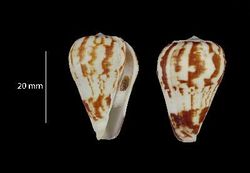
|
|---|---|
| Common Names | Cone snails. C. geographus is termed the cigarette snail because it is said that if you get stung, you will only have time to smoke a cigarette before dying. |
| Physical Description | Cone-shaped. 4 cm high by 2 cm wide. Mouth contains a potentially harmful harpoon-like stinger that contains neurotoxins called conotoxins with which they shoot their prey from their “proboscis.” The venom bulb delivers the venom from the venom duct to the prey. The rostrum engulfs the prey and several hours later, the snail spits out fish scales, fish bones, and the used harpoon. Another harpoon is retrieved from the radular sac. |
| Fossil Range | Eocene to present-day. |
| Taxonomy | Before 2009, cone-shaped snails were all clumped into Conus, but Conus has since been more precisely defined, with species splitting up into different genera. Subclass: Caenogastropoda Order: Neogastropoda Superfamily: Conoidea (Conacea) Family: Conidae |
| Mode of Life or Habitat | Benthic, predatory. Warm waters at various depths. Conus sensu lato inhabits depths from the sublittoral zone (which is permanently covered by water) to around 1000 m. |
| Distribution | Worldwide, especially tropical and subtropical seas. |
| Etymology | From its cone shape. |
| Additional Information | Conotoxins can be used to treat neuropathic pain or severe chronic pain. They are a mix of several different toxins made of peptides. They are known to have resulted in human fatality. |
| External Links | https://en.wikipedia.org/wiki/Conus. https://en.wikipedia.org/wiki/Conotoxin. https://www.sciencedirect.com/topics/neuroscience/conotoxin. https://www.sciencefriday.com/educational-resources/how-do-killer-snails-kill-their-victims/. https://www.youtube.com/watch?v=S_LjnwVxGL0. https://en.wikipedia.org/wiki/Conus_geographus. |
Genus Cypraea
| Picture(s) | 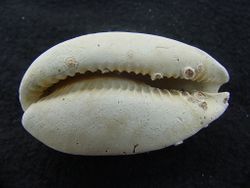
|
|---|---|
| Common Names | Cowries. |
| Physical Description | Their shells are egg-shaped and smooth. The outer and inner lips are covered in small, sharp ribs. They are about 2 cm long. |
| Fossil Range | Miocene (66.0 mya) to present-day. |
| Taxonomy | Clade: Caenogastropoda Clade: Hypsograstropoda Clade: Littorinimorpha Superfamily: Cypraeoidea (Cypraeacea) Family: Cypraeidae |
| Mode of Life or Habitat | Benthic. Marine. Known from seamounts and knolls. Ate algae and corals. |
| Adaptations Over Time | When a predator first touches the gastropod, it senses something soft, plump, and bright, but on the second touch, the gastropod withdraws the mantle and the predator touches something hard, shiny and brown. The confused predator thinks the gastropod has escaped and goes on looking for it elsewhere. |
| Distribution | Every continent except Antarctica. |
| Etymology | From Latin Cypria or Cypris, a name for Venus/Aphrodite from her mythic birthplace in Cyprus. |
| Additional Information | Sometimes used as jewelry or as currency, e.g. in West Africa, India, or China. |
| External Links | https://en.wikipedia.org/wiki/Cypraea. http://www.marinespecies.org/aphia.php?p=taxdetails&id=205978. http://fossilworks.org/bridge.pl?a=taxonInfo&taxon_no=9724. https://en.wikipedia.org/wiki/Shell_money. https://www.merriam-webster.com/dictionary/Cypraea. |
Genus Platyceras
| Picture(s) | 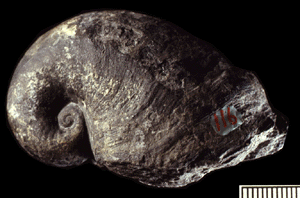
|
|---|---|
| Physical Description | They vary in shape. They are thin-shelled and have fine growth lines. They have a distinctive curved shell. |
| Fossil Range | Silurian to Permian (or Middle Triassic), 439-222 mya. Especially common during the Devonian and Carboniferous. |
| Taxonomy | Clade: Neritimorpha Superfamily: Platyceratoidea Family: Platyceratidae |
| Mode of Life or Habitat | Facultatively mobile. Epifaunal. Marine. Had a complex parasitic relationship with crinoids, possibly engaging in heterospecific coprophagy (consumption of feces), gametophagy (consumption of gametes), or kleptoparasitism (consumption of stolen food), obtaining energy from the crinoid without killing their host. |
| Distribution | Every continent except Antarctica. |
| Etymology | Likely from Greek platy (flat) + keras (horn). |
| Additional Information | One of the most abundant gastropods in the Paleozoic Era, possibly because of the layer of calcite in the shell. |
| External Links | https://en.wikipedia.org/wiki/Platyceras. https://www.sciencedirect.com/science/article/abs/pii/S0031018203006254?via%3Dihub. http://fossilworks.org/bridge.pl?action=taxonInfo&taxon_no=9117. https://www.britannica.com/animal/Platyceras. |
Genus Turritella
| Picture(s) | 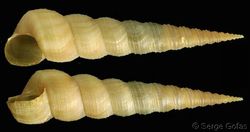
|
|---|---|
| Common Names | Turret shells |
| Physical Description | They look like little spires that are 5 cm high and 1.3 cm wide. They have winding growth lines, and the lip is thin. |
| Fossil Range | Late Jurassic to present-day. |
| Taxonomy | Subclass: Caenogastropoda Clade: Sorbeoconcha Superfamily: Cerithioidea Family: Turitellidae |
| Mode of Life or Habitat | Infaunal filter feeder. |
| Distribution | Worldwide. |
| Etymology | Comes from Latin "turritus" (towered) + "-ella" (small). |
| Additional Information | One of the most common Mesozoic fossils. Carbonate stone made of Turritella fossils is called Turritella limestone. Silicified Turritella fossils form Turritella agate. One variety of “Turritella agate” found in the Green River Formation in Wyoming contains Elimia tenera, not Turritella. |
| External Links | https://en.wikipedia.org/wiki/Turritella. |
Genus Worthenia
| Picture(s) | 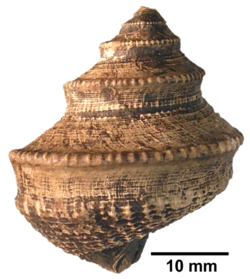
|
|---|---|
| Physical Description | Sea snail. The shell has a tall spire with a convex base. Wide, almost circular aperture. |
| Fossil Range | Late Devonian to Late Triassic/Early Jurassic, 354-183 mya. Especially common in the Late Carboniferous. |
| Taxonomy | Superfamily: Trochonematoidea Family: Lophospiridae |
| Mode of Life or Habitat | Marine filter feeder. Facultatively mobile. Epifaunal. |
| Distribution | Every continent except Antarctica and Africa. Most common in central regions of North America, e.g. from Idaho to Texas to Oklahoma to Ohio. |
| Etymology | Named after Amos Henry Worthen (1813-1888), a paleontologist. |
| External Links | https://en.wikipedia.org/wiki/Worthenia. https://www.britannica.com/animal/Worthenia. http://fossilworks.org/bridge.pl?a=taxonInfo&taxon_no=9388. |
Echinoderms (Phylum Echinodermata)
| Picture(s) | No pictures have been added as of yet. |
|---|---|
| Common Names | Echinoderms, including starfish, sea urchins, and sand dollars. |
| Physical Description | Radial symmetry (usually 5-point). However, larvae are bilaterally symmetrical. They can usually regenerate limbs. The have a skeletal system made out of calcite plates. Echinoid internal skeletons are made of a unique sponge-like structure called stereom, which is 50% living cells by volume and 50% a matrix of calcite crystals. They can make their connective tissue flexible or rigid, meaning they do not need muscular effort to maintain a position. They have a water vascular system for breathing, moving, and feeding. |
| Fossil Range | Echinoderms evolved during the Cambrian Explosion and survive to the present-day. |
| Taxonomy | There are around 20 classes of echinoderms, 5 of which are still alive to the present-day. Kingdom: Animalia |
| Mode of Life or Habitat | Strictly marine. Echinoderms exist at all depths. Some are sessile, some are motile, some are predatory or detritus feeders, and some are filter feeders. |
| Adaptations Over Time | Stereom likely evolved before other traits of echinoderms such as radial symmetry and may have been developed during a transition from an aragonite to a calcite sea during Stage 2 of the Cambrian. Some paleontologists used to think that stereom was present in the common ancestor between echinoderms and chordates (the calcichordate hypothesis) but this has since been discredited. |
| Distribution | Worldwide. |
| Etymology | The name "echinoderm" comes from "echino" (Ancient Greek for hedgehog) + "derm" (Ancient Greek for skin). |
| Additional Information | In pop culture, Patrick Star from the hit children’s show Spongebob Squarepants is an echinoderm. |
| External Links | https://web.archive.org/web/20151226052858/http://www2.humboldt.edu/natmus/impFossilTypes/Echinoderms/. https://en.wikipedia.org/wiki/Stereom. |
Class Asteroidea (Starfish)
This fossil will only be tested at the State and National levels.
| Picture(s) | 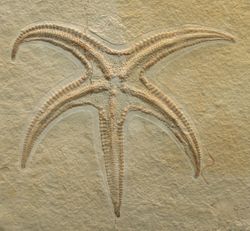
|
|---|---|
| Common Names | Starfish. Also known as true stars. |
| Physical Description | Shaped like stars and have many arms around a central disk. They have growth disks, usually the central disk, which can regrow entire limbs and range from 12-24 cm. |
| Fossil Range | Early Ordovician to present-day. |
| Mode of Life or Habitat | They live from the intertidal zone to the deep sea and eat sessile creatures such as barnacles and mussels. |
| Distribution | Worldwide. |
| Etymology | "Asteroidea" derives from the Ancient Greek "aster" (star). |
| External Links | https://en.wikipedia.org/wiki/Starfish. |
Class Blastoidea
| Picture(s) | No pictures have been added as of yet. |
|---|---|
| Common Names | Sea buds. |
| Physical Description | Protected by interlocking plates of calcium carbonate which formed the main body, or theca, usually attached to a stalk or column of plates. The mouth is on top of the theca. The ambulacra, or food grooves, were flower-like petals from the center which had bronchioles, or long, thin structures which were used to trap food. Five spiracle plates surrounded the mouth, anus, and respiratory organs known as hydrospires, which prevented mixing of fluids. |
| Fossil Range | Ordovician to Permian. |
| Mode of Life or Habitat | Stalked suspension feeders. |
| Etymology | Blastoidea comes from Ancient Greek "blastos" (bud). |
| External Links | https://en.wikipedia.org/wiki/Blastoid. |
Genus Pentremites
| Picture(s) | 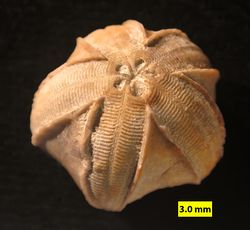
|
|---|---|
| Physical Description | Usually around 11 cm tall, but could grow up to 3 times that size. They had tentacle-like structures called bronchioles which they used for trapping food which floated by in currents. They had three plates: deltoid plates, radial plates, and basal plates. Its mouth is surrounded surrounded by 5 holes. |
| Fossil Range | Early Carboniferous to Permian (mostly restricted to Early Carboniferous). |
| Taxonomy | Order: Spiraculata Family: Pentrimitidae |
| Mode of Life or Habitat | Shallow, rough, and clear marine water. They lived on the seafloor, attached by a stalk. Water entered the pores near the bases of the arms, bathed the tissues lining the folds, and exited through the holes near the mouth. |
| Distribution | North America. The best specimens are found in Indiana, Kentucky, and Illinois. |
| Etymology | New Latin, from penta (five) + trēma (hole). |
| Additional Information | Sometimes incorrectly called "fossil nuts" or "fossil hickory nuts." Used as an index fossil for rocks of Mississippian age in North America. |
| External Links | https://en.wikipedia.org/wiki/Pentremites. |
Class Crinoidea
| Picture(s) | 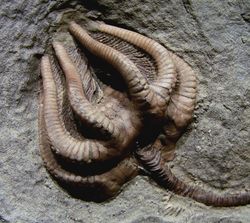
|
|---|---|
| Common Names | Sea lilies (stalked), feather stars (unstalked), comatulids (unstalked). |
| Physical Description | Have stems, calyxes, and arms. The stem is made of porous bone. The calyx has the organs, mouth, and anus. The arms have pentaradial symmetry and have smaller bones and cilia for feeding. Crinoids are motile and a vestigial stalk. In the deep sea, the stalks can grow up to 1 meter, but it is usually much smaller. There are plates of calcium carbonate, forming an endoskeleton. |
| Fossil Range | Ordovician to present-day. Were very common during the Paleozoic Era before the Permian-Triassic extinction, where most crinoids became extinct. In the Burgess Shale, Echmatocrinus is a Cambrian fossil which possibly resembles a crinoid, but it could also be an octocoral or some similar-looking specimen. |
| Taxonomy | Traditionally thought to have evolved from Blastozoa but some think that may have diverged from the lineage earlier. |
| Mode of Life or Habitat | Shallow water, depths of 6000 m. Filter feeders. |
| Adaptations Over Time | Two periods of abrupt adaptive radiation caused by increased predation pressure, during the Ordovician and the early Triassic. During the Mesozoic marine revolution, crinoids adopted the ability to swim/crawl, nocturnal behavior, and/or autotomy (the ability to discard limbs in self-defense). They also shifted to habitats farther offshore, where there was less predation. |
| Etymology | The word crinoid comes from Ancient Greek κρίνον (krínon) "lily" + -oid meaning "like." |
| Additional Information | Competitors are required to identify the stems, columns and calyxes of crinoids for this event. |
| External Links | https://en.wikipedia.org/wiki/Crinoid. https://en.wikipedia.org/wiki/Mesozoic_marine_revolution. |
Class Echinoidea
| Picture(s) | 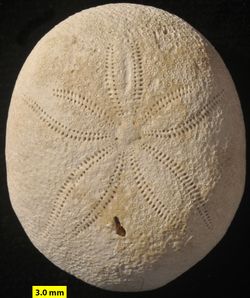
|
|---|---|
| Common Names | Sea urchins, sand dollars, and heart urchins. |
| Physical Description | Usually 6-12 cm but can reach 36 cm. They start life with bilateral symmetry but have pentaradial symmetry when mature (radial symmetry when viewed from the top). Can be shaped like a ball or disc. The lower half is the side with the mouth usually in the center (oral surface) while the upper half is the side with the anus (aboral surface). The mouth and anus are also called the peristome and priproct, respectively. The test is made of CaCO3 plates covered with two layers: a dermis and an epidermis. Echinoids can convert CO2 into raw material for their shells. They also have many tube feet, suckers that extend from the hydrostatic water-vascular system through holes in the test. These holes are in five distinct bands (ambulacra) that run vertically between the mouth and anus. The endoskeleton is made of spicules that are ~1-3 cm long. There are two shapes of echinoids, regular and irregular. Regular echinoids (sea urchins) have no front or back and can move in any direction. Irregular echinoids (sea potatoes and sand dollars) have a front side (the mouth side) and back side (the anal side) and therefore generally only move in a particular direction. Regular echinoids possess very complex and powerful jaws called Aristotle’s lanterns that extend through the mouth. These jaws are complex beaks with five teeth that leave a distinctive star-shape grazing pattern. Irregular echinoids have ambulacra that sink into a petal shape on the top of the body. |
| Fossil Range | Ordovician to modern-day. Their fossil record is poor until the Mesozoic Era. Irregular echinoids evolved from regular echinoids during the early Jurassic. |
| Mode of Life or Habitat | They live in marine benthic environments from rocky shores to the hadal zone. Regular echinoids search the seafloor for food, grasping food with their tube feet or collecting and scraping food with their Aristotle’s lanterns, and use their spines for protection and locomotion. Minute defensive spines are called pedicellariae, which can be venomous or possess pincers to deter parasites and clear detritus. Regular echinoids are mostly scavengers and can eat algae and other plant matter, animal detritus, sponges, molluscs, and barnacles. Irregular echinoids burrow along the seafloor and bulk-feed on the sediment to extract nutrients. Irregular echinoid spines lost their defense role and are reduced and hair-like, helping to burrow, move, gather food, and create circulatory currents inside the burrow. Many irregulars do not have the complex jaws regular echinoids have, and the tube feet become flanges for respiration in addition to gathering food. |
| Distribution | All oceans in all climates. |
| Etymology | "Echinoidea" comes from Comes from "echino" (Ancient Greek for hedgehog and then Latin for sea urchin). |
| Additional Information | Most echinoids quickly lose their spines after death, so most fossils are either isolated tests or solitary spines. Isolated jaw-parts can also be common, but they are easily overlooked or misidentified. Pedicellariae are almost never preserved. Irregular echinoids are much more common fossils than regular echinoids. |
| External Links | https://en.wikipedia.org/wiki/Sea_urchin. http://www.discoveringfossils.co.uk/echinoids.htm. |
Class Ophiuroidea (brittle stars)
This fossil will only be tested at the State and National levels.
| Picture(s) | 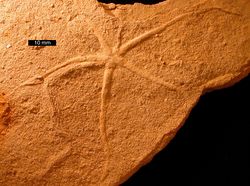
|
|---|---|
| Common Names | Brittle stars. |
| Physical Description | Strong pentaradial symmetry. They are like starfish except the central disk is marked off from the arms. The arms are snake-like. The underside of the disk contains the mouth. |
| Fossil Range | Early Ordovician to present-day. |
| Mode of Life or Habitat | Live in both shallow marine water and the deep sea. Most are scavengers and detritus feeders but can prey on small animals and be filter-feeders. |
| Etymology | Ophiuroidea comes from the Ancient Greek word for “serpent,” ὄφις. |
| External Links | https://en.wikipedia.org/wiki/Brittle_star. |


